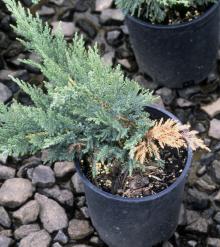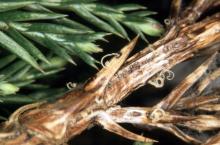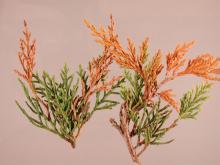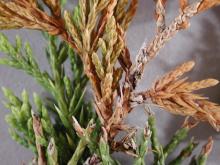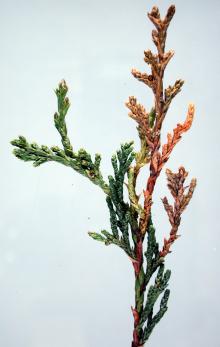See:
Juniper Cultivar Susceptibility
Cause The fungus Diaporthe juniperivora (formerly Phomopsis juniperovora) is found most often in western Oregon. Kabatina juniperi also causes a tip blight but is rare in western Oregon. Kabatina tip blight is more common in eastern Washington and throughout nursery markets east of the Rocky Mountains. Cultivars differ in susceptibility to both fungi. J. chinensis 'Pfitzeriana Aurea' is considered resistant to both. Mostly a nursery problem and not present in the landscape as much.
Time and location of infection also differ. Diaporthe infection occurs whenever foliage is young and moisture and humidity are high-generally, spring. Older, mature foliage is resistant to infection. Excessive pruning or shearing in summer will stimulate new, succulent growth that is highly susceptible. Kabatina infection is thought to occur in fall and often is associated with wounds, insect feeding, or mechanical damage.
Symptoms Both fungi cause a foliar blight and tip dieback, which are difficult to separate. Diaporthe-affected foliage first turns dull red or brown and finally ash-gray. Small gray lesions often girdle branch tips and kill the foliage beyond the diseased tissue. Small, black, fruiting bodies (pycnidia) develop in lesions. Most blighting is on the terminal 4 to 6 inches of branches. Repeated blighting in early summer can result in abnormal bunching of shoots, which may resemble a witches' broom. Young trees or shrubs may be stunted with discolored foliage and may eventually die.
Symptoms of Kabatina infection generally are before those of Diaporthe. The ends of branches turn dull green then red or yellow. Small ash-gray to silver lesions dotted with small, black, fruiting bodies (acervuli) are visible at the base of the discolored tissue. Generally, this fungus does not result in extensive branch dieback or tree death, which could indicate a root problem.
Cultural control
- Prune out and burn affected twigs and branches.
- Avoid wounding twigs.
- Avoid overhead irrigation or apply such that plants are not wet for extended periods of time.
- Do not over-fertilize.
- Space plants for good air circulation.
- Grow resistant plants.
- Select cuttings only from disease-free stock plants.
Chemical control Spray at 2-week intervals in spring, beginning when new growth starts. Additional applications may be needed after pruning or shearing when new growth is stimulated.
- Cleary's 3336 EG at 16 to 24 oz/100 gal water. Group 1 fungicide. 12-hr reentry.
- CuPRO 5000 at 1.5 to 5 lb/A but only up to 2 lb/A when new growth is present. Group M1 fungicide. 48-hr reentry.
- Heritage at 1 to 4 oz/100 gal water plus a non-silicone-based wetter sticker. Group 11 fungicide. 4-hr reentry.
- Kocide 3000 at 0.75 to 1.75 lb/A. Group M1 fungicide. 48-hr reentry. O
- Mancozeb-based products can be used as mixing partners and provide some protection. Group M3 fungicides. 24-hr reentry.
- Fore 80 WP at 1.5 lb/100 gal water plus a spreader-sticker.
- Protect DF at 1 to 2 lb/100 gal water plus 2 to 4 oz spreader-sticker.
- Mural at 4 to 7 oz/100 gal water. Group 7 + 11 fungicide. 12-hr reentry.
- Phyton 27 at 1.3 to 2.5 oz/10 gal water. Group M1 fungicide. 48-hr reentry.
- Propiconazole-based products. Group 3 fungicides.
- Banner MAXX at 5 to 8 fl oz/100 gal water. 12-hr reentry.
- Infuse Systemic Disease Control at 1 Tbsp/gal water. H
- ProCon-Z at 5 to 8 oz/100 gal water. 24-hr reentry.
- Tourney EZ at 1 to 4 oz/100 gal water. Group 3 fungicide. 12-hr reentry.
References Punithalingam, E. and Gibson, I.A.S. 1973. Phomopsis juniperovora. CMI Descriptions of Pathogenic Fungi and Bacteria. No. 370.
Hsiang, T., Huang, J., Yang, L., Cook, S., Shen, Y., and Richter, K.J. 2000. Occurrence of Kabatina juniperi in Ontario and genetic analysis using RAPD markers. Canadian Journal of Plant Pathology 22:79-88.


